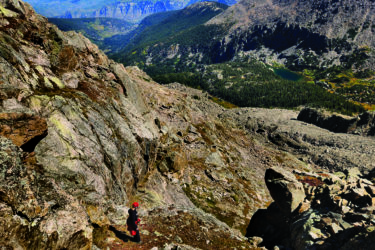The Local newsletter is your free, daily guide to life in Colorado. For locals, by locals.
The growing popularity of outdoor recreation and Colorado’s surging population have led to more diehards striving for the state’s loftiest summits during our coldest months—when they’re even more striking and not crowded by hikers. With winter fourteener season running from mid-December till the spring equinox (March 20 this year), you have a few more weeks to follow in their footprints. However, cold-weather climbs are more demanding than summertime attempts, so use this guide to ensure you summit safely.
Pre-Climb Checklist
- Go to School
Identifying and avoiding avalanche terrain is crucial. REI and the nonprofit Friends of Berthoud Pass offer free avalanche awareness courses. The Colorado Avalanche Information Center also provides classes around the state and a forecast map on its website. - Choose Your Climb
We recommend the east ridge of Quandary Peak for a debut because the avalanche danger is relatively low. - Check the Weather
You’ll want a sunny day with a high in the 20s or above and max sustained winds below 25 mph. Depending on the temp, gusts higher than that often invite frostbite. - Find Snowshoes that Shine
Like the Evo Ascent by MSR. Built-in steel crampons and heavy-duty bindings make the snowshoes durable enough for an arduous journey—one that’s much more manageable with trekking or ski poles. - Pick a Pal
A trusted, experienced climbing partner will help handle emergencies—plus, you’ll need something to eat if you become stranded.
1. At the Trailhead
Rise early: Breaking trail through snow takes at least twice as long as hiking a dry trail; plan to leave your car at 4 or 5 a.m. for excursions in the 15-mile range and 7 a.m. for shorter treks like Quandary (seven miles round-trip). Also: Dirt roads leading to fourteeners are rarely plowed, meaning you might need to hike a few miles just to reach the trailhead.
Let there be light: For navigating the predawn dark, carry a powerful, durable headlamp, like Black Diamond’s Storm, as well as an emergency spare and extra batteries.
Cache your food: Stash snacks—enough fare to eat at least once an hour—in an inner jacket pocket, using body heat to keep them from freezing.
2. Below Treeline
Shed your threads: Deeper snow leads to added exertion and, thus, sweat. If possible, strip to a shell, a fleece, or a synthetic T-shirt (stay away from moisture-holding cotton) to avoid soaking through your clothes. Wet garb is dangerous in the wind-ripped world above treeline.
Observe the right way: Knowing how to use a map and compass is essential to ensure you stay on the correct trail. Just in case: The Gaia GPS app provides navigation tools that work on your smartphone without cell service.
3. Above Treeline
Armor up: To guard against windburn above treeline—about 11,000 feet at Quandary—cover every inch of exposed skin. We’re talking balaclava, ski goggles, waterproof mittens (which retain heat far better than gloves) lined with synthetic insulation, and, of course, bountiful layers.
Don new kicks: The upside of howling wind? It blows snow off the mountain, allowing you to ditch snowshoes for lightweight Kahtoola Microspikes. The downside? It leads to greater avalanche danger, so be vigilant.
4. At the Peak
Soak up the solitude: From June through mid-October, about 334,000 hikers attempt to summit fourteeners. Quandary sees only 22 visitors on an average winter Saturday. Translation: Enjoy the alone time; you’ve worked plenty hard to get it. That being said…
Don’t dally: Getting down usually takes half as long as the ascent. With the winter sunset arriving as early as 4:40 p.m. in Summit County, though, you should turn around no later than early afternoon—whether you make the peak or not.









